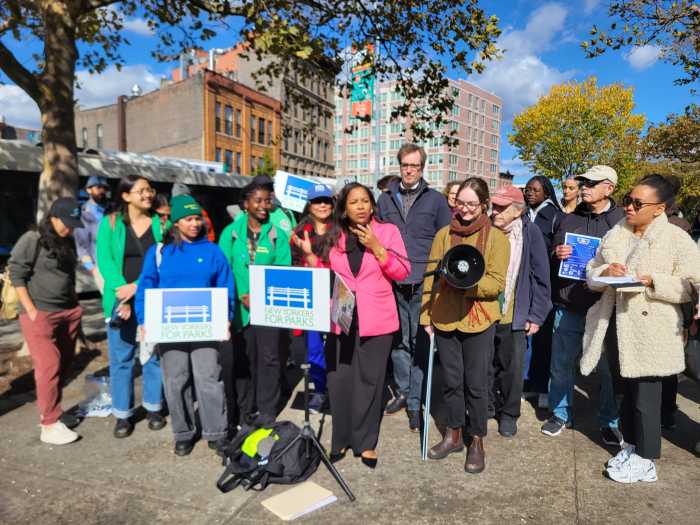A leading fiscal watchdog sounded the alarm Thursday over the deteriorating state of New York City’s rent-stabilized housing stock — warning the Rent Guidelines Board (RGB) that without urgent action, the city risks a spiraling maintenance crisis akin to the one plaguing NYCHA.
Sean Campion, director of housing and economic development studies at the Citizens Budget Commission, told the board that a significant share of stabilized buildings, particularly those built before 1974, are “in poor condition and a growing number are in financial distress.”
“The City should act now to stop the physical and financial deterioration of the rent-regulated stock before these problems grow worse and enter the maintenance ‘death spiral’ observed in New York City Housing Authority (NYCHA) buildings,” Campion testified.
Rent Guidelines Board told of crumbling apartments

The testimony came during the RGB’s May 22 meeting at Spector Hall in Manhattan, part of a series of public sessions leading up to a final vote on June 25 on proposed rent increases for stabilized apartments – ranging from 1.75% to 4.75% for one-year leases and 4.75% to 7.75% for two-year leases.
Campion suggested that the board approve rent hikes that “at a minimum, keep pace with inflation,” citing falling net operating incomes for stabilized buildings and a sharp drop in capital improvement activity since the passage of the 2019 Housing Stability and Tenant Protection Act (HSTPA).
“Several years of sub-inflation rent increases approved by the RGB have impeded the building owners’ ability to invest in maintenance and repairs,” Campion said.
He pointed to data from the city’s 2023 Housing and Vacancy Survey showing that pre-1974 stabilized units have an average of 1.76 maintenance deficiencies, 75% more than post-1973 stabilized units and 79% more than market-rate rentals. “The gap between pre-1974 units and NYCHA units… has also narrowed,” he said.
Reinvestment with rent hike ‘can’t be assumed’
Other testimony, however, challenged the idea that rent hikes would improve housing conditions.
Benjamin Teresa, a professor in Urban and Regional Studies and Planning in the School of Government and Public Affairs at Virginia Commonwealth University, challenged the assumption that guideline increases translate into more investment in buildings. He cited research showing that collected rents average just 67.4% of legal rents, due to widespread rent arrears and market constraints.
“It can’t be assumed that the guideline increases directly translate to increased revenues for reinvestment in a statewide stock,” he said.
“At the same time, all these increases have direct and immediate harms for households,” the professor added.
Concerns were also raised by housing researchers throughout the day, including Emily Eisner of the Fiscal Policy Institute, who argued that the RGB’s role is not to ensure financial returns for landlords, but to minimize tenant displacement. “It’s not so much a dual mandate. It’s one objective function that has a serious constraint that you need to be thinking about,” Eisner said during the meeting.
“Raising the rent in this environment will exacerbate the risk of… displacement, and that is already high,” she said. “It’s important to state there’s a short-term need for the city and state to both increase housing supply alongside rent regulation, and then there’s a long-term need for this process to be depoliticized, and rent stabilization to be indexed to a cost increase that’s stable and predictable.”
Campion warned that neglecting the financial health of buildings could have downstream costs for the city. “Inaction will only further increase repair costs, push them onto the City and State, and threaten the quality of life of many of the 1.7 million New Yorkers who live in pre-1974 stabilized units,” he said.
He also criticized the city’s current preservation programs as expensive and limited in scale. “The average cost of repairing properties taken through the Third Party Transfer In Rem program is now reportedly $250,000 per unit,” he said, “while… the Neighborhood Pillars program… allows subsidies of up to $380,000 per unit.”
‘Landlords have nowhere to go’
Real estate investors also offered sobering perspectives. David Aviram, co-founder of Maverick Real Estate Partners, which makes its money by buying distressed loans secured by commercial real estate in the city, testified that “nearly half of the debt… about $130 billion of commercial real estate debt secured by rent-stabilized multifamily properties” is highly concentrated in buildings that are 75% to 100% rent stabilized.
Shimon Shkury, president of Ariel Property Advisors, said the market for stabilized properties is struggling. “Tenants are feeling the dilapidation in their buildings, and landlords have nowhere to go but to you for increases,” he told the board. Based on his commercial brokerage firm’s research, he estimated that about 20% of stabilized buildings in their pipeline are “distressed,” meaning they require lender intervention or are already in financial workout processes.
“There were pre-HSTPA (Housing Stability and Tenant Protection Act), there were a lot of larger companies investing in rent-stabilized buildings because they wanted to add value and get a return. That’s clearly not the case anymore,” he said. “The investors today are smaller private investors, and they’re looking at things very long term. Rising interest rates have accelerated the physical decline in these assets.”
In 2024, the city saw a rare net gain of nearly 15,000 rent-stabilized units, driven largely by new construction under the 421-a tax incentive program, according to the Rent Guidelines Board’s annual stock report. The program accounted for the vast majority of the 25,940 units added, while 11,042 units were removed from stabilization due to expiring tax benefits, conversions, or demolitions. Despite the year’s increase, the city has lost more than 138,000 rent-stabilized apartments since 1994.
RGB staff also presented data detailing low vacancy rates and rising overcrowding in stabilized housing. According to the board’s data, the citywide rental vacancy rate is just 1.41%, with stabilized units facing a lower 0.98% rate. Overcrowding affects 13.1% of stabilized households.
The RGB will hold three additional public hearings in June before its final vote on June 25.








































